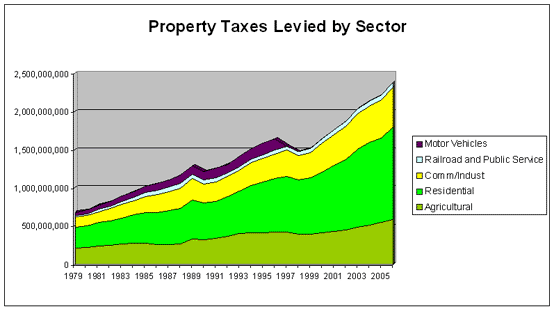
Taxes in Nebraska > Sources of Major State and Local Taxes > Property Taxes > Property Taxes by Sector
PROPERTY TAXES BY SECTOR

*NOTE: The growth rate in inflation over this period was 245% and the growth rate in the economy, as measured by Nebraska personal income was 422%.
[
Click on a sector of property taxes in the legend of
the chart above
to the to view information related to that sector. ]
| Some activity on the chart above -- such as spikes and troughs -- can be traced to policy decisions made by the Legislature. To view additional information about these changes, click on a bill number below. A chronology of legislative action will open in a new window; the bill you selected will be viewable at the top of the new page. | |
| YEAR | LEGISLATIVE ACTIVITY |
| 1989 | LB 84 |
| 1990 | LB 1059 |
| 1992 | LB 1063 |
| 1997 | LB 271 |
| 1998 | LB 806; LB 1114 becomes operative |
| 2002 | LB 898 |
| 2003 | LB 540 |
| 2006 | LB 968 |
|
The area chart above shows the growth of the property tax by economic sector. You can view information about each property tax sector by clicking on a title in the legend box to the right of the chart. Residential property taxes are an increasing share of the total tax property tax burden, growing from about 40% in 1980 to more than 50% today. School finance reforms in 1990 and 1998 and the imposition of levy limits significantly affected the growth of the property taxes in the 1990s. The elimination of the property tax on motor vehicles in 1997 also affects the sector analysis. You may click on an item of legislative activity in the table above to view more information about the effects of legislation on property taxes. The Increasing Share of the Property Tax Borne by Residential Property The property tax burden falls on residential property to a greater extent than was true 30, or even ten years ago. In 1971, 39% of all property taxes were levied on agricultural real and personal property, 28% on commercial, industrial, and centrally assessed real and personal property, 27% on residential real estate and 7% on motor vehicles. In 1994, 41% of all property taxes were levied on residential real estate, 27% agricultural real estate and personal property, 23% commercial, industrial, and centrally assessed real and personal property, and 9% motor vehicles. In 1995, farm home sites were reclassified from the agricultural sector to the residential sector, raising the percentage of the taxes borne by residential real estate to 45% in 1996. The removal of motor vehicles from the property tax base in 1997 increased the residential share to 50%. In 2006, the share reached 50.8%. In addition to legislative changes, this shift has several explanations: 1. The farm crisis of the 1980s severely depressed the value of agricultural land and lowered the share of the property taxes being borne by agricultural land. From 1980 through 1989, the share of the property taxes paid on agricultural land declined from 33.5% to 24%. At this time, the state also had fiscal difficulties that prevented any significant increase in state aid to local governments. Increasing the share paid by all three non-agricultural sectors made up for this decrease in share. This era also saw changes taking place in agricultural valuation brought on by litigation. In Kearney Convention Center Inc. v. Board of Equalization, 216 Neb. 292, 344 N.W.2d 620 (1984), the Supreme Court held that the uniformity requirements of the Nebraska Constitution demanded that agricultural land be assessed uniformly compared to other property valued at 100% of actual value. The Legislature and the voters quickly approved a constitutional amendment allowing the separate classification of agricultural land and for a few years, Nebraska used an income approach to value. Then, the Nebraska Supreme Court determined in Banner County v. State Board of Equalization, 226 Neb. 236, 411 N.W.2d 35 (1987) that separate classification did not mean that the values determined need not be correlated to actual value. A later constitutional amendment and subsequent legislative action enacted the current approach to the valuation of agricultural land at 75% of actual value. 2. The early 1990s saw the personal property tax crisis. The personal property tax crisis began when railroads questioned whether the treatment of personal property by a number of state tax systems, including Nebraska's complied with the federal Railroad Revitalization and Regulatory Reform Act of 1976 (4-R Act). The 4-R Act was a comprehensive piece of legislation designed to save railroads from financial collapse. It contained many provisions regarding rate setting, branch line preservation and regulatory reform. It also contained Section 306(1)(d) which prohibited the imposition of any tax that disciminated against railroads. The Act defined "discrimination" with reference to income producing property, commercial, industrial, and agricultural. The U.S. Court of Appeals in Trailer Train v. Leuenberger, 885 F.2d 415 (8th Cir., 1988) held that the exemptions for agricultural and business inventories, livestock, and farm machinery meant that the personal property tax in Nebraska discriminated against railroads which typically did not own such property. The Court enjoined collection of the personal property tax against railroads. Similar litigation had been successful in many other states at that time. Unlike other states, in Nebraska this course of litigation took another turn. The Nebraska Supreme Court ruled in Northern Natural Gas v. State Board of Equalization, 232 Neb, 806, 443 N.W.2d 249 (1989) that the uniformity clause of Nebraska's constitution required that pipelines, telephone companies, and other centrally assessed taxpayers were entitled to have their personal property "equalized" to that of railroads, which were paying no tax under federal law. Therefore, no personal property tax could be constitutionally collected. The Court later ruled in MAPCO Ammonia Pipeline v. State Board of Equalization, 238 Neb. 565, 471 N.W.2d 734 (1991) that all personal property tax exemptions previously granted were unconstitutional, reversing earlier case law. The Legislature responded by placing a constitutional amendment on the ballot that (1) separated real and personal property for purposes of the uniformity clause, (2) allowed personal property exemptions, (3) allowed legislation revising the method of assessment of taxable personal property and (4) carved out a separate class of railroad personal property. It was adopted by the people at the primary election of 1992. To settle the litigation with centrally assessed taxpayers, the Legislature adopted legislation to add farm equipment back to the property tax base at net book value and change the assessment of business equipment assessment from actual value to net book value. Net book value is defined as cost less depreciation as set out in depreciation tables in the statute. The old method was market value. This assessment change resulted in about 20% less value attributable to business equipment than had been the case in the 1980s. While the addition of farm machinery to the tax rolls broadened the tax base in rural areas, urban areas that had business equipment but not farm machinery saw a reduction in tax base, and a shift in tax burden to residential property. Also, railroads received a downward adjustment in value to reflect the proportion of the potential property tax base that is exempt from taxation. 3. The explosive growth of sanitary and improvement districts as a means of residential development has also led to the shift of property taxes paid toward the residential sector. SIDs levy very high property taxes, especially in the early years, to pay off bonds issued for improvements. The developer counts on the development being a success, so the valuation increases enough to fund itself at a more moderate tax rate. Eventually, it is hoped that the SID area will be annexed into the nearby city, but until it does, the costs are borne by residential property alone and not the entire economic community that is more likely to have commercial and industrial property. 4. Finally, the economy of the state has changed. Certainly, all agree that the share of the economy supported by agriculture is shrinking. What may be less obvious is the impact that the growth of the service economy has on the property tax base. There is less and less need for factories filled with expensive machinery to provide employment and growth in Nebraska. In today's world, business equipment is frequently a computer or computers that not only decline in price every year, but are placed on a three year depreciation schedule for net book value determination. Consequently, economic growth these days is reflected most directly in the growth of residential real estate rather than productive property. Between 1992 and 1996, residential value increased 53% while commercial, industrial, and centrally assessed real and personal property value increased 27%. Agricultural real estate value increased only six percent and agricultural personal property taxable value decreased almost 10%, largely due to the exemption of breeding livestock beginning in 1995. |
Additional Information: